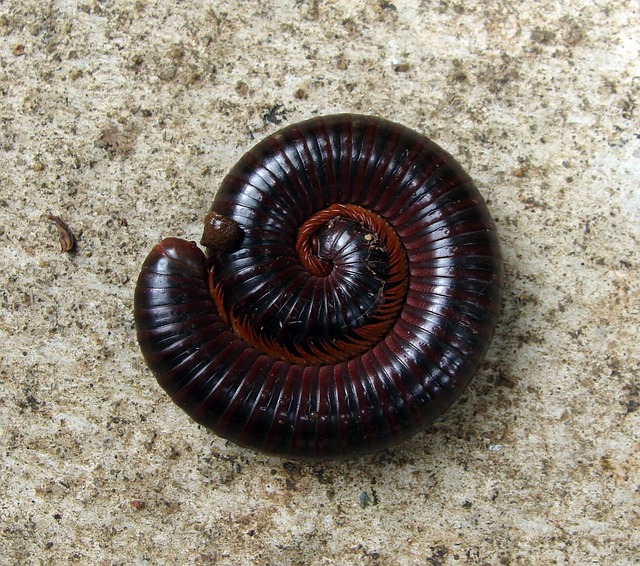Millipedes are resilient pests that thrive in dark, humid environments with organic matter and moisture. While homes can manage them through cleaning, reducing humidity, and sealing entry points, commercial spaces demand a more robust strategy. This includes stringent sanitation, regular inspections, targeted treatments, and structured approaches to control populations, focusing on food prep areas to prevent re-infestations. Early identification of millipedes, strategic sealing of entry points, regular inspections, and eco-friendly IPM methods are crucial for effective commercial millipede control. Professionals tailor their methods based on species, behavior, and structure for successful long-term prevention.
Millipedes, though unwelcome intruders, present unique challenges in both residential and commercial spaces. This article offers a comprehensive guide to understanding and addressing these creepy crawlers. We explore their behavior, habitat preferences, and specific signs of infestation in various settings. For businesses, we provide effective commercial millipede control strategies tailored to professional needs. Similarly, homeowners can find valuable, personalized solutions for managing millipedes in their homes, ensuring comfort and peace of mind. Discover expert tips for a millipede-free environment with our detailed insights into commercial millipede control.
Understanding Millipedes: Behavior and Habitat in Residential and Commercial Settings
Millipedes are a common pest in both residential and commercial spaces, known for their distinctive many-segmented bodies and numerous legs. Understanding their behavior and habitat is crucial in implementing effective millipede control strategies. In homes, millipedes often hide in dark, humid areas like basements, crawl spaces, and behind appliances. They are attracted to organic materials such as wood, paper, and plant debris, which serve as both food sources and hiding places. Commercial settings face similar challenges, with millipedes drawn to environments that offer moisture and shelter, commonly found in kitchens, bathrooms, and storage rooms.
Residential and commercial millipede control require distinct approaches. In homes, regular cleaning, reducing moisture levels, and sealing entry points can deter millipedes. Commercial facilities should focus on thorough sanitation, especially in food preparation areas, and implementing a structured pest management program that includes regular inspections and targeted treatments to disrupt millipede populations and prevent re-infestations.
Identifying Signs of a Millipede Infestation
Millipedes are often overlooked until their presence becomes a significant issue, especially in residential and commercial settings. Identifying an infestation early is crucial for effective commercial millipede control. One of the first signs to look out for is visible millipedes scurrying across floors or walls. While they prefer dark, damp areas, a sudden increase in sightings could indicate an underlying problem. Cracks, crevices, and spaces behind appliances or baseboards are common hiding places, so regular inspections in these zones can help catch the issue early.
Other signs include small mounds of earth near entry points, as millipedes often tunnel their way into buildings through gaps and cracks. If you notice any unusual soil deposits or strange smells, it might be a good idea to call in professional commercial millipede control services. Prompt action can prevent these pests from infesting large areas and causing damage to structures and belongings.
Effective Commercial Millipede Control Strategies
Millipedes are a common nuisance in both residential and commercial settings, capable of infesting a wide range of environments. When it comes to commercial spaces, effective millipede control requires a strategic approach tailored to the specific needs of the premises. One of the primary steps is identifying entry points and sealing them off to prevent further infestations. Regular inspections are crucial, especially in areas prone to moisture accumulation as millipedes thrive in such conditions.
Implementing integrated pest management (IPM) strategies is a comprehensive solution. This involves combining various methods such as baits, traps, and biological control agents like nematodes that target millipedes specifically. Professional pest control services can offer tailored treatments, ensuring the use of eco-friendly products where possible to maintain a safe and healthy environment for both business operations and customers.
Tailored Residential Solutions for Millipede Management
When it comes to residential millipede management, a tailored approach is key. Homeowners often face unique challenges when dealing with these persistent pests due to varying environments and entry points. Professional pest control services offer specialized solutions that consider the specific species of millipedes infesting a property, their behavior patterns, and the structural aspects of the building.
One effective strategy involves targeting millipede harbourage areas such as crawl spaces, basements, and dense vegetation nearby. This may include sealing entry points, improving ventilation, and applying targeted treatments using eco-friendly chemicals or biological control agents. Regular inspections and maintenance are crucial to prevent reinfestation, ensuring a long-term solution for commercial millipede control at residential properties.
In addressing millipede issues, both residential and commercial properties require tailored strategies. Understanding these creatures’ unique behaviors and habitats is crucial for effective management. For homes, targeted residential solutions can eliminate infestations, while commercial spaces benefit from robust strategies that prevent and control outbreaks. With the right approach, it’s possible to restore peace of mind and maintain pest-free environments. Implementing the discussed methods will ensure a comprehensive understanding and successful mitigation of millipede problems in various settings, highlighting the importance of professional commercial millipede control measures.
